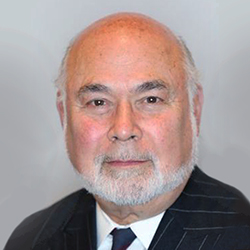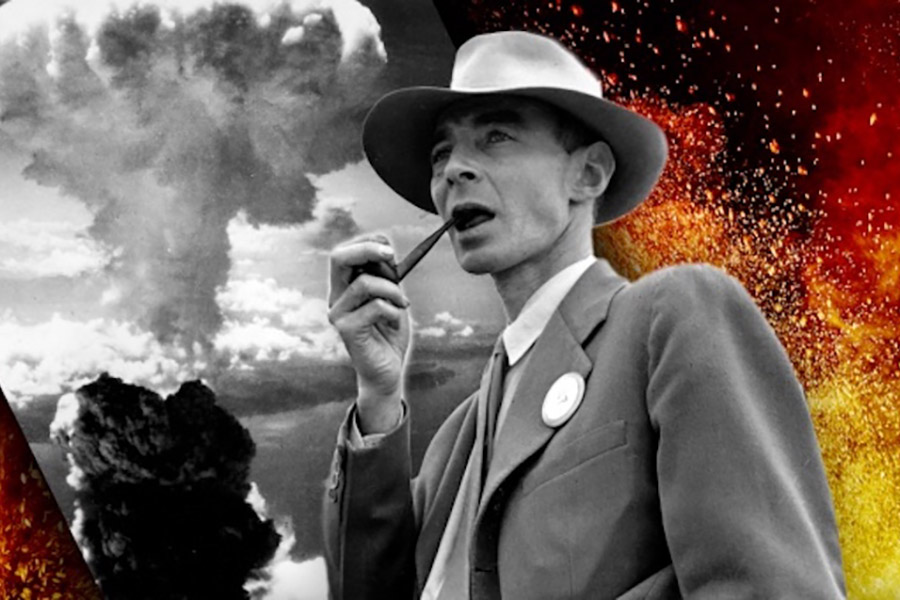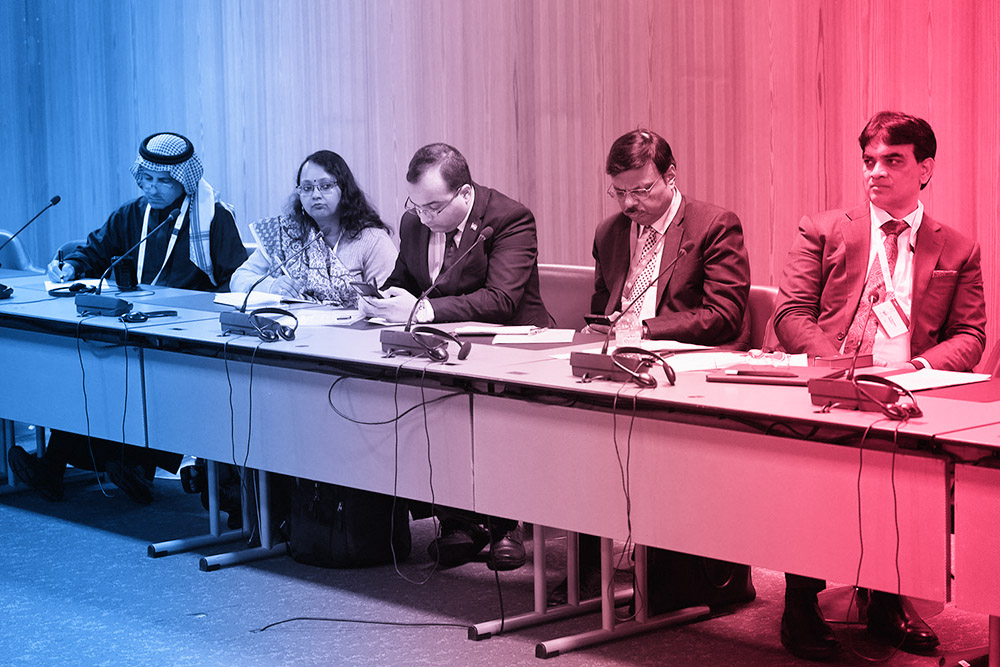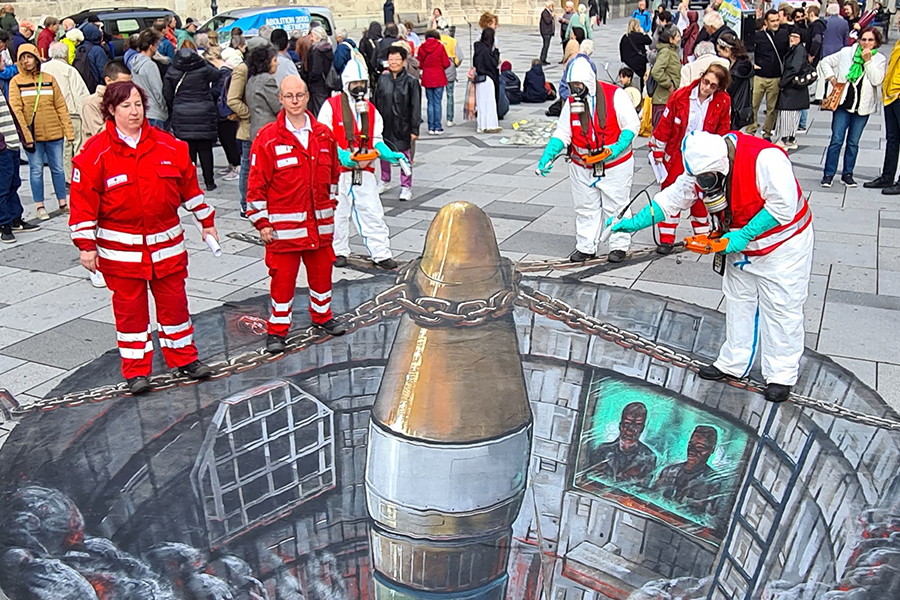Presentation by Jonathan Granoff, President Global Security Institute
delivered to the Halki Summit on “Global Responsibility and Environmental Sustainability: A Conversation on Environment, Ethics, and Innovation”
June 18-20, 2012
Istanbul, Turkey
Albert Einstein said: The unleashing of power of the atom bomb has changed everything except our mode of thinking, and thus we head toward unparalleled catastrophes.
Brigadier General T.F. Farrell described the moment he saw the blast of the first atomic bomb: The effects could well be called unprecedented, magnificent, beautiful, stupendous, and terrifying. No man-made phenomenon of such tremendous power had ever occurred before. The lighting effects beggared description. The whole country was lighted by a searing light with the intensity many times that of the midday sun. It was golden, purple, violet, gray and blue. It lighted every peak, crevasse and ridge of the nearby mountain range with a clarity and beauty that cannot be described and must be seen to be imagined. Seconds after the explosion came, first, the air blast pressing hard against the people, to be followed almost immediately by the strong, sustained awesome roar which warned of doomsday and made us feel we puny things were blasphemous to dare tamper with the forces heretofore reserved for the Almighty.
George Kennan, the distinguished American diplomat who originated the Cold War containment policy toward the Soviet Union, said: The readiness to use nuclear weapons against other human beings – against people we do not know, whom we have never seen, and whose guilt or innocence is not for us to establish – and, in doing so, to place in jeopardy the natural structure upon which all civilization rests, as though the safety and perceived interests of our own generation were more important than everything that has taken place or could take place in civilization: this is nothing less than a presumption, a blasphemy, an indignity – an indignity of monstrous dimensions – offered to God!
Margaret Beckett, then-UK Foreign Secretary, said: When William Wilberforce began his famous campaign the practice of one people enslaving another had existed for thousands of years. He had the courage to challenge that paradigm. In so doing, he helped to bring an end to the terrible evil of the transatlantic slave trade. Would he have achieved half as much? Would he have inspired the same fervor in others if he had set out to regulate or reduce the slave trade rather than abolish it? I doubt it.
The reigns of law and morality are necessary to control the horses of technology and science and guide them from destruction into the greener pastures of creativity and service for life. This is an existential and spiritual necessity in the nuclear age.
The nuclear weapons age began at 5:29:45 a.m. Mountain War Time, July 16, 1945, when the first atom bomb was tested in a portion of the bleak barren Alamogordo bombing range in the New Mexico desert chillingly named Jornado de Muerto (Journey of Death). After the thunderous roar of the shock wave, a huge pillar of smoke rose 30,000 feet, creating the first icon of the nuclear age—the fearsome mushroom cloud. A blast of energy of unprecedented destructive magnitude bathed the surrounding mountain in a brilliant light that could be seen 150 miles away. J. Robert Oppenheimer, Director of the Los Alamos Laboratory, the organization responsible for the design of the first atomic bomb as part of the Manhattan Engineer District of the War Department, uttered a sober description from the Hindu scripture, the Bhagavad-Gita: “‘Now I am become Death, destroyer of worlds.’”
This soon gave rise to the capacity of a small group of people, political and military leaders of a hand full of countries, to decide whether or not to end humanity. The use of a small portion of the arsenals in existence could entirely reverse Genesis and erase the holy scripture of created living existence on planet earth. Is planning, organizing, spending vast amounts of money (over seven trillion dollars thus far), and daily deploying personnel and weapons at the ready to accomplish this feat, the apex of human genius in the service of destruction, an activity regarding which we should take a moral position? Should we be silent? If such activity is not “sin” then what is?
There are now over 20,000 nuclear bombs in existence with deployed and ready arsenals in the hands of eight nations containing over thousands of megatons of destructive energy. This is a global arsenal more than sufficient to destroy the world many times over. Conventional weapons typically have a destructive capability measurable in the release of some number of tons of TNT. A fission bomb, which we refer to as an “atomic” bomb, is the kind that was dropped on Hiroshima and Nagasaki and has the destructiveness of thousands of tons of TNT (kilotons). “Little Boy,” dropped on Hiroshima, was approximately 12–15 kilotons, and “Fat Man,” the plutonium fission bomb, dropped on Nagasaki, had about 22kilotons. “Fusion (hydrogen’ or thermonuclear) bombs, have the destructiveness of up to some millions of tons of TNT (megatons,mt). Presently the arsenals of the US and Russia alone have the destructive capacity of over several hundred thousand Hiroshima-type bombs.
There is no environmental threat greater than the consequences of the explosion of these arsenals. Even a limited war would have a devastating and immediate impact on a global scale dramatically harming the climate and in turn agriculture and stability.
Distinguished climate scientists such as Alan Robock and Brian Toon have studied the consequences of a regional nuclear exchange in South Asia and concluded that the use of about 100 Hiroshima sized bombs(relatively small by today’s standards) on urban areas would be a global environmental catastrophe. The blast and firestorms would promptly kill over 20 million people immediately and widely disperse radioactive fallout. The explosions and fires would then propel over 5 million tons of soot and smoke into the upper atmosphere. Within days the temperature on the planet would drop 1.25-1.5 degrees Celsius. This abrupt cooling and darkening would reduce rainfall causing agricultural disasters, mostly in the heartlands of America, Africa and Eurasia. The effects would persist for more than a decade.
Building on these studies the Nobel Peace Laureate organization International Physicians for the Prevention of Nuclear War, notably Doctors Ira Helfand and Tilman Ruff, and other eminent scientists, have conservatively estimated that beyond the consequences to the countries at war, this “limited” nuclear war would directly put over a billion people at risk of starvation. In addition, the ozone layer, which protects the surface of the Earth from harmful ultraviolet radiation, would be depleted by 40% over many inhabited areas and up to 70% at the poles. For anyone with a sense of environmental responsibility the abolition of nuclear weapons is a clear imperative.
Each U.S. Trident submarine can destroy 100 cities and produce the global famine described in the study. The United States has 14 of them, a fleet of land-based nuclear missiles, and an arsenal of nuclear weapons that can be delivered by bombers. The Russians possess the same grotesque overkill capacity.
In addition to the security imperative there is a legal duty to achieve nuclear disarmament and an ethical duty to fulfill promises made to do so. The five declared nuclear weapon states14—United States, United Kingdom, Russia, China, and France—have solemnly obligated themselves under Article VI of the NPT to nuclear disarmament and affirmed “[a]n unequivocal undertaking by the nuclear-weapon States to accomplish the total elimination of their nuclear arsenals leading to nuclear disarmament to which all States parties are committed under Article VI.” This legal duty does not contain an enforceable timeline.
Many of the 182 non-nuclear weapon states parties to the NPT have been induced to legally bind themselves, under the NPT, to refrain from developing nuclear weapons by the disarmament commitment of the nuclear nuclear-weapon states: China, France, Russia, United Kingdom, United States. Israel, Pakistan and India and North Korea are the only countries presently not members of the Treaty. However, presently, despite quantitative reductions in the arsenals of Russia and the US, all of these states are either modernizing or growing their arsenals and none are taking the step of advancing the commencement of negotiations on a treaty or framework of legal instruments, as UN Secretary General Ban Ki-moon has urged, to achieve nuclear disarmament. In fact over $100 billion will be spent this year on these horrific devices.
Can a nuclear apartheid world be a secure situation? Can this unequal situation be sustained? Imagine if the Biological Weapons Convention universally banning biological weapons stated that no country can use polio or small pox as a weapon but nine countries could use the plague as a weapon to maintain international peace and security? This would be obviously impractical, incoherent and immoral. We all recognize that the plague is an immoral and illegal weapon because of its destructive indiscriminate effects no matter who might use it. Nuclear weapons we know are far more dangerous.
The extent of this danger is not sufficiently appreciated by the public. It is our duty to change this. General Lee Butler was US Commander of Strategic Nuclear Forces, with the day to day responsibility for operations, discipline, training of tens of thousands of crew members, the systems that they operated and the warheads those systems were designed to deliver. He said: “Despite all the evidence, we have yet to fully grasp the monstrous effect of these weapons, that the consequences of their use defy reason, transcending time and space, poisoning the Earth and deforming its inhabitants.”
Nuclear weapons are “inherently dangerous, hugely expensive and militarily inefficient.” General Butler stated that “accepting nuclear weapons as the ultimate arbiter of conflict condemns the world to live under a dark cloud of perpetual anxiety. Worse, it codifies mankind’s most murderous instincts as an acceptable resort when other options for resolving conflict fail.” He added, “I have spent years studying nuclear weapons effects . . . have investigated a distressing array of accidents and incidents involving strategic weapons and forces . . . I came away from that experience deeply troubled by what I see as the burden of building and maintaining nuclear arsenals. . . the grotesquely destructive war plans, the daily operational risks, and the constant prospect of a crisis that would hold the fate of entire societies at risk.”
It should be clear that nuclear weapons themselves constitute more of a problem than any problem they address. As long as some have them and extol their value others will seek and eventually obtain them thus increasing daily the risk of proliferation. As long as they exist the risk they will be used, either by design, accident, or madness, increases. Any use would be unacceptable. The conclusion is that steps must immediately be taken to lower their political currency, stop their spread, reduce their numbers, reduce the risks of their use, and begin a legal, verifiable, universal process leading to their prompt elimination. The risk presses us to action.
How many unlikely events happen every day? Think of the meltdown at Fukushima, or the unlikely and rapid end of the Cold War. The consequences of the unexpected assassination of Archduke Ferdinand in Sarajevo that led so quickly to World War I must be placed in context and serve as a warning. Historian Eric Hobsbawn reminds us: “The international atmosphere seemed calm. No persons had been assassinated at frequent intervals for decades. In principle, nobody even minded a great power leaning heavily on a small troublesome neighbor. Since then some five thousand books have been written to explain the apparently inexplicable: how, within a little more than five weeks of Sarejevo, Europe found itself at war.”
We cannot be surprised today by any scenario wherein thousands of weapons are still positioned in launch-on-warning mode, known terrorists itch to take down the current social order directly or by precipitating a large conflict. Add to this the ongoing and increasing practices of cyber interference, religious fanaticism, sophisticated criminal organizations, civil wars, wars between developing countries and dangerous insecurities in the Middle East, and we cannot be surprised if any, some or all of these events conspire to produce a bloody, broad and protracted war. But with nuclear weapons in the mix, there might not be any books written after such an “unexpected” mishap.
It is an arrogant illusion to think that by accident, mechanical failure, or foolish human folly these weapons will never be used. Even under the best of circumstances mistakes can be made. General Lee Butler said that after he studied deeply into the history of the incidents and the accidents of the nuclear age as they had been recorded by the US and USSR “…it is more chilling than anything you can imagine.” He recounted, “Missiles that blew up in their silos and ejected their nuclear warheads outside of the confines of the silo. B52 aircraft that collided with tankers and scattered nuclear weapons across the coast and into the offshore seas of Spain. A B52 bomber with nuclear weapons aboard that crashed in North Carolina, and on investigation it was discovered that on one of those weapons, 6 of the 7 safety devices that prevent a nuclear explosion had failed as a result of the crash. There are dozens of such incidents. Nuclear missile-laden submarines that experienced catastrophic accidents and now lie at the bottom of the ocean.”
The Cuban Missile Crisis gave the world 13 days to reach safety. How much time is enough to rectify human or mechanical error? How much time is there in a crisis between India and Pakistan, a computer hacker creating an illusion of attack, or a terrorist posing as a state actor? What threat to our security is possibly greater than the threat posed by the weapons themselves?
Resting the security of civilization on the certainty that deterrence-based deployments capable of ending civilization in an afternoon will never fail in preventing the unthinkable is an unacceptable and logically unsustainable risk. It is also arrogant. It is an unstable means of pursuing security that is, in truth, unworthy of civilization.
Some might ask “There are so many good causes why should I work on this one?” The answer is that the cooperation needed to address many global security issues will not be achieved in a nuclear apartheid world, where the means of unimaginable mass destruction are permitted for some, eschewed by most, yet envied by others.
There is an obvious similarity in solutions that seek to address a wide range of present serious global threats, such as: protecting biodiversity; reversing the depletion of fishing stocks; controlling ocean dumping; preventing ozone depletion; halting global warming; controlling and eliminating terrorism; fighting pandemic diseases; ending the tragedy of crushing poverty and lack of clean drinking water; regulating the financial markets; and addressing crises arising from failed states.
New levels of international cooperation, trust, and law are necessary. Will this be accomplished in a world where several nations consider their security interests so superior to all others that they claim that nuclear weapons are legitimate for them but not others? Nuclear weapons elimination is part of the pursuit of a global security order that must be achieved.
General Omar Bradley stated,
“We live in an age of nuclear giants and ethical infants, in a world
that has achieved brilliance without wisdom, power without conscience.
We have solved the mystery of the atom and forgotten the
lessons of the Sermon on the Mount. We know more about war
than we know about peace, more about dying than we know about living.”
From a religious perspective there is a clear duty to act.
If killing one innocent person is a sin; how shall we evaluate the organized preparedness to kill all people by the creation of devices the use of which is only established by the credible deployment and readiness to use them?
All human beings, of any and every race, color, ethnicity, level of intelligence, religion, language, nationality, gender, character, behavior, physical or intellectual capacity, are of immeasurable value, possess inherent inviolable dignity, and are sacred. Some faith traditions state that the human being is made in the “image of God.”
These insights lead to the protection of the individual and invoke a moral duty that every person has toward all others. At what stage of the development of the individual this inherent sacred value commences is open to debate, but the inherent value of the individual is a normative value recognized in all current civilizations. Murdering individuals is thus illegal and unacceptable.
Ironically, the organizations which should advocate this supreme ethical perspective, while often vocal about the status of the fetus, when it comes to nuclear weapons which could annihilate billions, if not all, such sacred individuals, are, as a practical matter, virtually silent. It is true and good that several Popes have made pronouncements decrying nuclear weapons and the Grand Ayatollah has even issued a fatwa condemning them. That is not the same as admonishing and clarifying on a regular basis at every level of clerical leadership that moral accountability attaches to personal and national policies and actions.
There is a need to convene religious leaders who are concerned about life, the environment, and moral and spiritual values along with policy experts and plan ways and means of working together to end the threat posed by nuclear weapons, to make the issue a local and personal moral concern for every person and to bring their institutions into accord with these aspirations.
Annex 1
What a nuclear bomb does:
Former US CIA Director Stansfield Turner has said:
The horror of a nuclear weapon’s actual affects are illustrated in the following:
The fireball created by a nuclear explosion will be much hotter than the surface of the sun for fractions of a second and will radiate light and heat, as do all objects of very high temperature. Because the fireball is so hot and close to the earth, it will deliver enormous amounts of heat and light to the terrain surrounding the detonation point, and it will be hundreds or thousands of times brighter than the sun at noon. If the fireball is created by the detonation of a 1-MT [megaton] nuclear weapon, for example, within roughly eight- to nine-tenths of a second each section of its surface will be radiating about three times as much heat and light as a comparable area of the sun itself. The intense flash of light and heat from the explosion of a 550-KT weapon can carbonize exposed skin and cause clothing to ignite. At a range of three miles, for instance, surfaces would fulminate and recoil as they emanate flames, and even particles of sand would explode like pieces of popcorn from the rapid heating of the fireball. At three and a half miles, where the blast pressure would be about 5psi, the fireball could ignite clothing on people, curtains and upholstery in homes and offices, and rubber tires on cars. At four miles, it could blister aluminum surfaces, and at six to seven miles it could still set fire to dry leaves and grass. This flash of incredibly intense, nuclear-driven sunlight could simultaneously set an uncountable number of fires over an area of close to 100 square miles.
Takashi Hiraoka, then Mayor of Hiroshima, told the International Court of Justice:
The atomic bombs dropped on Hiroshima and Nagasaki shattered all war precedent. The mind-numbing damage these nuclear weapons wrought shook the foundations of human existence. . . .The dropping of the nuclear weapons is a problem that must be addressed globally. History is written by the victors. Thus, the heinous massacre that was Hiroshima has been handed down to us as a perfectly justified act of war. As a result, for over 50 years we have never directly confronted the full implications of this horrifying act for the future of the human race. Hence, we are still forced to live under the enormous threat of nuclear weapons . . . .Beneath the atomic bomb’s monstrous mushroom cloud, human skin was burned raw. Crying for water, human beings died in desperate agony. With thoughts of these victims as the starting point, it is incumbent upon us to think about the nuclear age and the relationship between human beings and nuclear weapons . . . . The unique characteristic of the atomic bombing was that the enormous destruction was instantaneous and universal. Old, young, male, female, soldier, civilian – the killing was utterly indiscriminate. The entire city was exposed to the compound and devastating effects of thermal rays, shock wave blast, and radiation . . . Above all, we must focus on the fact that the human misery caused by the atomic bomb is different from that caused by conventional weapons. [H]uman bodies were burned by the thermal rays and high-temperature fires, broken and lacerated by the blast, and insidiously attacked by radiation. These forms of damage compounded and amplified each other, and the name given to the combination was “A-bomb disease. . . .[T]he bomb reduced Hiroshima to an inhuman state utterly beyond human ability to express or imagine. I feel frustrated at not being able to express this completely in my testimony about the tragedy of the atomic bombing . . . .It is clear that the use of nuclear weapons, which cause indiscriminate mass murder that leaves survivors to suffer for decades, is a violation of international law.
Judge Christopher Weeramantry, former Vice President Judge of the International Court of Justice, has written:
Here is an eyewitness description from the first use of the weapon in the nuclear age – one of hundreds of such scenes which no doubt occurred simultaneously, and many of which have been recorded in contemporary documentation. The victims were not combatants, as was the case at Solferino: “It was a horrible sight. Hundreds of injured people who were trying to escape to the hills passed our house. The sight of them was almost unbearable. Their faces and hands were burnt and swollen; and great sheets of skin had peeled away from their tissues to hang down like rags on a scarecrow. They moved like a line of ants. All through the night they went past our house, but this morning they had stopped. I found them lying on both sides of the road, so thick that it was impossible to pass without stepping on them.
“And they had no faces! Their eyes, noses and mouths had been burned away, and it looked like their ears had been melted off. It was hard to tell front from back. One soldier, whose features had been destroyed and was left with his white teeth sticking out, asked me for some water but I didn’t have any. [I clasped my hands and prayed for him. He didn’t say anything more.] His plea for water must have been his last words.”9
Multiply this a thousand-fold or even a million-fold and we have a picture of just one of the many possible effects of nuclear war. Massive documentation details the sufferings caused by nuclear weapons – from the immediate charring and mutilation for miles from the site of the explosion, to the lingering after-effects – the cancers and the leukemias which imperil human health, the genetic mutations which threaten human integrity, the environmental devastation which endangers the human habitat, the disruption of all organization, which undermines human society.
The Hiroshima and Nagasaki experience were two isolated incidents three days apart. They tell us very little of the effects of multiple explosions that would almost inevitably follow in quick succession in the event of a nuclear war today …Moreover, fifty years of development have intervened, with bombs being available now which carry seventy or even seven hundred times the explosive power of the Hiroshima and Nagasaki bombs. The devastation of Hiroshima and Nagasaki could be magnified several-fold by just one bomb today, leave alone a succession of bombs.
Annex 2
Why the status quo is unacceptable to a responsible person:
These are a few examples that indicate the folly of permitting the world’s fate to hang in the balance of but a few people often given but a few minutes to decide whether there will be a future.
November 9, 1979, computers at three U.S. military command centers simultaneously picked up over 200 missiles from the Soviet Union headed for the United States. Officials had only minutes to assess what appeared to be a massive, first-strike nuclear attack. As minutemen missile launch control centers in the Midwest were readied, national security advisor Zbigniew Brzezinski prepared to call President Carter and when he was informed that threat was reassessed at 2,200 missiles, enough to end the United States, and by fallout and nuclear winter, perhaps the entirety of civilization. Just before he picked up the phone, he was informed that the satellites designed to detect launches and early warning radar systems indicated that there was no missile attack at all. Senator Charles Percy had been visiting a defense facility and an officer, wanting to impress the politician regarding the seriousness of his mission, had mistakenly put a training tape into the wrong computer.
On June 3, 1980, U.S. command posts again indicated a Soviet attack, and again launch crews for Minuteman missiles were given preliminary launch warnings and bomber aircraft manned. Computer displays showed two missiles attacking, then none, and then 200. A simple computer chip had malfunctioned.
On August 30, 2007, a U.S. B-52 bomber was mistakenly armed with six nuclear warheads and flown for more than three hours across several states. On October 19, 2007, the Department of Defense and Air Force released a report that concluded handling standards and procedures had not been followed. Four commanders were relieved of their commands, numerous personnel were disciplined, and, in the wake of this and other incidents, Secretary of the Air Force Michael Wynne and Chief of Staff of the Air Force General T. Michael Moseley resigned.
While U.S. nuclear near-misses might be underreported, we know only a fraction of the errors that occurred in the silos and command posts of the former Soviet Union.
On September 26, 1983, the Soviet Union’s launch detection satellites reported that U.S. Minuteman intercontinental missiles had been launched. Lt. Col. Stanislav Petrov, however, concluded that his satellites had malfunctioned and, on his own authority, prevented a Soviet alert.
On January 25, 1995, the Russians mistook a weather satellite for a nuclear weapon launch from a submarine off the coast of Norway. President Yeltsin said the next day that he had activated his “nuclear football”—a device that allows the Russian president to communicate with his top military advisors and review the crisis in real time. Recent mishaps should cause continuing concern:
Such incidents are not unique to the United States and Russia:
On February 3, 2009, the Vanguard, a British Royal Navy nuclear submarine, and Le Triomphant, a French nuclear vessel, collided in the Atlantic Ocean. Both carried nuclear warheads and were on routine patrol. Defense officials said they were “unable to see each other.”
Even under the best of circumstances, amid good relations between countries, mistakes can, and have been made—especially given the limited time allowed to discern fact from fiction. As President Reagan admitted: “Six minutes to decide how to respond to a blip on a radar scope and decide whether to unleash Armageddon! How could anyone apply reason at a time like that?”
Security experts in the West often reference South Asia as the most dangerous nuclear fault line, largely because of the instability of Pakistan. Whether they are correct or not, the dangers inherent in the US and Russian ventures are enough to stimulate a vigorous initiative to eliminate nuclear weapons globally.
Annex 3
Moral and Ethical Investments in a Sustainable Future
A new activism based on responsibility to future generations, sustainability and the implicit reverence for life.
This is a call for all institutions with a moral mandate, especially religions, to bring their values and investment policies into coherence. Investments in companies that benefit from environmental degradation and weapons of indiscriminate effect should be moved into industries aligned with enterprises that advance sustainable practices, or at least do no harm.
The goal of this proposal is to stimulate and facilitate a divestment campaign in religious institutions. Using the Norwegian pension fund divestment campaign as a model, this campaign would seek to put forward the proposition that such morally founded institutions must not invest in such a manner as to encourage activities which are against sustainability. It would advance the idea that we have duties to future generations and that environmentally irresponsible practices and the use of weapons of indiscriminate effect (land mines, cluster munitions, nuclear, biological and chemical weapons) are morally and practically unsustainable.
There is already a widely recognized movement to advance environmentally sustainable business practices and, as the Norwegians have so insightfully pointed out, there is a relationship in values and practice to the growing movement to eliminate weapons of indiscriminate effect, especially nuclear weapons.
We simply must now put into place legal, verifiable, and enforceable mechanisms based on our shared moral values to outlaw all weapons of indiscriminate effect. Chemical and biological weapons have been so classified, and nuclear weapons must become so. Raising public awareness by advocacy for practical change will help.
A morally-based investment campaign could help raise consciousness and be of benefit to socially responsible financial institutions as well. Also, it would amplify the engagement of citizens in the security debate.
Norwegian Example
In the autumn of 2002, the Government appointed a committee to propose ethical guidelines for the Government Petroleum Fund. As the Graver fund reports:
The ethical guidelines for the Government Petroleum Fund are based on two premises:
“The Government Petroleum Fund is an instrument for ensuring that a reasonable portion of the country’s petroleum wealth should benefit future generations. The financial wealth must be managed with a view to generating a sound return in the long term, which is contingent on sustainable development in the economic, environmental and social sense. The Fund’s financial interests should be consolidated by using the Fund’s ownership interests to promote sustainable development. The Government Petroleum Fund should not make investments which constitute an unacceptable risk that the Fund may contribute to unethical acts or omissions, such as violations of fundamental humanitarian principles, serious violations of human rights, gross corruption or severe environmental degradation.“
Accordingly, the Fund implemented the following mechanisms to implement the Ethical Guidelines:
· Exercise of ownership rights in order to promote long-term financial returns based on the UN’s Global Compact and the OECD Guidelines for Corporate Governance and for Multinational Enterprises.
· Negative screening of companies from the investment universe that either themselves, or through entities they control, produce weapons that through normal use may violate fundamental humanitarian principles.
· Exclusion of companies from the investment universe where there may be an unacceptable risk of contributing to:
o Serious or systematic human rights violations, such as murder, torture, deprivation of liberty, forced labor, the worst forms of child labor and other child exploitation
o Grave breaches of individual rights in situations of war or conflict
Severe environmental degradation
o Gross corruption
o Other particularly serious violations of fundamental ethical norms
The moral underpinnings of such an initiative are well-established.
RESOURCES
A summary of the Guidelines and Mechanism implemented by the Norwegian Government: https://www.regjeringen.no/en/dep/fin/Selected-topics/the-government-pension-fund/responsible-investments/The-Graver-Committee—documents/The-Graver-Committee-and-Ethical-Guideli.html?id=434926# Longer version of the Norwegian Government’s White Paper outlining the guidelines: https://www.regjeringen.no/en/dep/fin/Selected-topics/the-government-pension-fund/responsible-investments/The-Graver-Committee—documents/Report-on-ethical-guidelines.html?id=420232#
Personal Postscript:
An aspect of the evidence of true spiritual sensitivity is to feel the suffering of others as one’s own, compassion, and to love them with an open heart. Acting from that awakened sacred sensibility is to be truly human. That is unity and brings the presence of the divine into human affairs wherever it arises.
As the Sufi Saint Bawa Muhaiyadeen said:
If each of you will open your heart, your action, your wisdom, and your conduct, and look within, you will see that every face is your face … all sorrow is your sorrow…. When that state develops inside you, that is God’s love … If that love develops, you will not hurt any other living thing. You will not cause pain, you will not reject any life. And you will not torture any other life. Because if you hurt anyone, it will hurt you.
That awakening naturally guides to serve life, the Creator’s gift of the world, and the lives with which He fills it:
Transformation
The heart without the hand withers
The hand without the heart is dangerous
When God’s qualities bring the two together as one
Chaos becomes balance
Salt turns to sugar
A world of violence, fear, betrayal, and suffering filled with tears of grief
Transforms into
Living examples of service, love, compassion, insight, inspiration, peace, filled with tears sweetened with joy and gratitude.
May these gifts be yours.
Jonathan Granoff is the President of the Global Security Institute, a representative to United Nations of the World Summits of Nobel Peace Laureates, a former Adjunct Professor of International Law at Widener University School of Law, and Senior Advisor to the Committee on National Security American Bar Association International Law Section.








